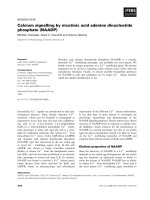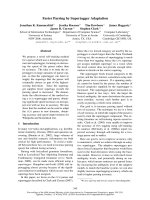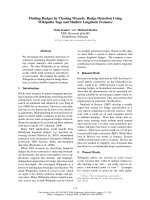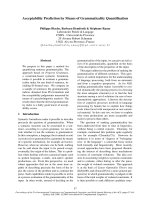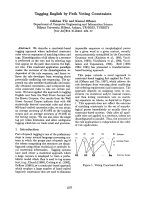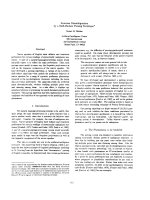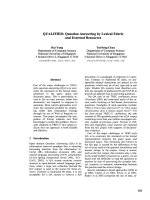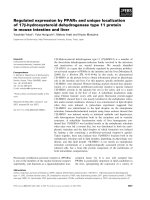Báo cáo khoa học: Neptunium uptake by serum transferrin potx
Bạn đang xem bản rút gọn của tài liệu. Xem và tải ngay bản đầy đủ của tài liệu tại đây (159.39 KB, 6 trang )
Neptunium uptake by serum transferrin
Isabelle Llorens
1
, Christophe Den Auwer
1
, Philippe Moisy
1
, Eric Ansoborlo
1
, Claude Vidaud
1
and
Harld Funke
2
1 CEA Marcoule, Bagnols sur Ce
`
ze Cedex, France
2 Rossendorf beamline, Grenoble, France
Metallobiomolecules are considered as elaborated inor-
ganic complexes with well designed metal active sites.
Although the various interaction processes between
essential metallic cations and proteins have been widely
studied, focus on the actinide family is more seldom
[1,1a,2]. In particular, the interaction of these cations in
the biologically active sites is only partially understood.
Sequestration and transport of iron in vertebrates are
carried out by transferrin (Tf), a monomeric glyco-
protein of 80 kDa. Crystal structures of transferrins
reveal that these proteins consist of a polypeptide chain
folded in two similar but not identical lobes. Each of
them contains one metal binding centre [3,4]. Serum Tf
is reported to bind a wide variety of d-block transition
metals, as well as actinides and lanthanides [3,5–7].
Furthermore, Taylor et al. have suggested that the
protein is able to stabilize the tetravalent state and
forms stable (M
4+
)
2
–Tf complexes [8]. This is why Tf
contamination by actinide cations is a critical issue of
nuclear human toxicology. The oxidation state IV of
neptunium (Np) has been of particular concern for its
relative stability in physiological conditions and reacti-
vity similarities with both Pu(IV), Th(IV) and Fe(III).
Pu(IV) as well as most of the transition metal cations
reported to be complexed by Tf are assumed to be
located in the iron sites [9]. In the case of Fe the donor
atoms are provided by two tyrosyl phenolates, one hist-
idyl imidazole and one aspartate carboxyl. The require-
ment of a synergistic bidentate carbonate anion has
been confirmed [10]. Other synergistic anions have also
been reported as the nitrilotriacetic anion (NTA) in
the crystallographically characterized structure of
Fe(III)(NTA)(Tf) [11]. Aspartate has a dual role: it
provides an oxygen ligand to the metal and allows the
formation of a hydrogen bond, helping stabilization of
the lobes in a closed configuration. Other residues not
directly coordinated to iron also play important roles
through hydrogen bonding as described by the crystal
structure of MacGillivray et al. [12] in which arginine
stabilizes the synergistic carbonate.
Combined extended X-ray absorption fine structure
spectrometry (EXAFS) and absorption spectrometry
are ideal complementary probes to characterize the Np
coordination site in the metalloprotein. On the one hand
Keywords
neptunium; serum transferrin; XAS
Correspondence
C. Den Auwer, CEA Marcoule,
DEN ⁄ DRCP ⁄ SCPS, 30207 Bagnols sur Ce
`
ze
Cedex, France
Fax: +33 4 66 79 63 25
Tel: +33 4 66 79 62 89
E-mail:
(Received 26 November 2004, revised 19
January 2005, accepted 8 February 2005)
doi:10.1111/j.1742-4658.2005.04603.x
Although of major impact in terms of biological and environmental haz-
ards, interactions of actinide cations with biological molecules are only par-
tially understood. Human serum transferrin (Tf) is one of the major iron
carriers in charge of iron regulation in the cell cycle and consequently con-
tamination by actinide cations is a critical issue of nuclear toxicology.
Combined X-ray absorption spectroscopy (XAS) and near infrared absorp-
tion spectrometry were used to characterize a new complex between Tf and
Np (IV) with the synergistic nitrilotriacetic acid (NTA) anion. Description
of the neptunium polyhedron within the iron coordination site is given.
Abbreviations
EXAFS, extended X-ray absorption fine structure spectrometry; NIR, near infrared; NTA, nitrilotriacetic acid; Tf, transferrin; XAS, X-ray
absorption spectroscopy.
FEBS Journal 272 (2005) 1739–1744 ª 2005 FEBS 1739
spectrometric data provide a fingerprint of the specific
complexation mechanism and on the other hand, in
the EXAFS regime of X-ray absorption spectrometry
(XAS), a quantitative description of the cation coordi-
nation sphere can be achieved.
Results and Discussion
To avoid hydrolysis at physiological pH, Np(IV) in
initial stock solution was complexed by NTA. Among
the Tf synergistic anions as carbonate, oxalate
or citrate, nitrilotriacetic acid is a well known chelat-
ing agent that can be used for actinide(IV) [13,14].
Fig. 1 shows the spectrometric near infrared (NIR)
spectra exhibiting the characteristic absorption band
of Np(IV)
aq
, Np(IV)(NTA) and Np(IV)(NTA)
2
com-
plexes at 960, 973 and 980 nm, respectively [14]. The
band at 960 nm for Np(IV)
aq
is spectroscopically
described as an internal 5f)5f transition and is very
sensitive to coordination modification [15]. In the
visible range, the spectra also exhibit characteristic
bands at 724, 732 and 740 nm, respectively. The
presence of a band at 724 nm and the absence of
any band at 610 nm confirm that the spectral evolu-
tion cannot be attributed to the oxidation of Np(IV)
to Np(V) but is characteristic of the Np(IV)–NTA
complex.
To identify the formation of a complex between
apoTf and Np(IV) with the NTA synergistic anion (a)
the titration of Np(IV) with 2.8 equivalents of NTA
by apoTf (Fig. 2A) and (b) the titration of apoTf by
Np(IV) with 2.8 equivalents of NTA (Fig. 2B) has
been followed by spectrometry in the NIR and visible
regions. Fig. 2A shows the evolution of the absorption
band at 980 nm of Np(IV) in the Np(IV)(NTA)
2
com-
plex upon apoTf titration. The band at 980 nm decrea-
ses and a new band appears at 995 nm from
[Tf] ⁄ [Np] ¼ 0 to [Tf] ⁄ [Np] ¼ 1.27. In the visible region
(data not shown) the band at 740 nm decreases and
new bands at 747, 732 and 727 nm appear. Again, the
absence of any band at 610 nm precludes the presence
of Np(V). The L
III
edge XANES spectrum of Np in
Tf(Np(IV)NTA)
2
(data not shown) also confirms the
oxidation state (IV) of Np in the complex [absence of
any shoulder at around 15 eV above the edge charac-
teristic of the transdioxo form in which Np is at oxida-
tion state (V) or (VI)].
This result and particularly the isobestic point at
987 nm is a characteristic fingerprint of the formation
of a new Np(IV) complex with Tf and NTA as synergis-
tic anion. Moreover, the total disappearance of the
absorption band that is characteristic of Np(IV)(NTA)
2
for two equivalents of apoTf suggests the stoechiometry
1 : 2 for the new complex, as observed for Fe(III).
Accordingly, the reaction between apoTf, Np(IV) and
NTA can be written as shown in Eqn (1).
2NpðIVÞþ2NTA þ apoTf () Tf ðNpðIV ÞNTAÞ
2
ð1Þ
Fig. 2B presents the spectrometric evolution of the
titration of apoTf by a mixture of Np(IV) with 2.8
equivalents of NTA from [Tf] ⁄ [Np] ¼0.68–0.26. At the
beginning of the titration process, the two complexes
Np(IV)(NTA)
2
and Tf(Np(IV)NTA)
2
are in equilib-
rium according to Eqn (1), as characterized by the two
absorption bands at 980 and 995 nm. Upon titration
and decrease of [Tf] ⁄ [Np], disappearance of the charac-
teristic absorption band of the Tf(Np(IV)NTA)
2
com-
plex at 995 nm, the isobestic point at 987 nm and the
concomitant increase of the band at 980 nm indicates
the formation of Np(IV)(NTA)
2
because of the large
excess of NTA in the solution. This confirms the equi-
librium described by Eqn (1). The Np L
III
edge
EXAFS spectrum and corresponding Fourier transform
of Tf(Np(IV)NTA)
2
are presented in Fig. 3A and B.
From the pseudo radial distribution function (R + F ),
backscattering contributions from the first Np neigh-
bours (I) and from second shell contributors (II) are
clearly observed. In the adjustment of the EXAFS
spectrum, the typical coordination number of eight
was set for Np(IV). Two oxygen shells with 5.2 atoms
at 2.34 A
˚
(r
2
¼ 0.007 A
˚
2
) and 2.8 atoms at 2.56 A
˚
(r
2
¼ 0.025 A
˚
2
) and one carbon shell of 7.4 atoms
at 3.37 A
˚
(r
2
¼ 0.009 A
˚
2
) were necessary to obtain a
Fig. 1. NIR spectrometry of Np(IV)
aq
, Np(IV)(NTA) and Np(IV)(NTA)
2
.
Experimental conditions are as described in Experimental proce-
dures.
Neptunium uptake by serum transferrin I. Llorens et al.
1740 FEBS Journal 272 (2005) 1739–1744 ª 2005 FEBS
satisfactory adjustment (R factor ¼ 0.06). The fit qual-
ity is very poor above 3 A
˚
because of the high signal-
to-noise ratio and the short data range (only EXAFS
data up to 8.5 A
˚
)1
were considered because of the
presence of a glitch at 9 A
˚
)1
). These results will be
compared to the structure of the coordinating lobe in
TfFe(III)(NTA) [11] for which iron is coordinated to
two tyrosines at a mean distance of 1.83 A
˚
and a
tetradentate NTA (three O at 1.99 A
˚
and one N at
2.76 A
˚
) in a highly distorted octahedral symmetry.
From a steric point of view, the global increase of the
size of the Np coordination sphere vs. that of iron(III)
can be explained by the increase in ionic radii although
the coordination symmetry is radically different
between the two cations.
A putative model based on the crystal structure of
TfFe(III)(NTA) [11] with Np in the Tf iron binding
site with two tyrosines, one tetradentate NTA and two
additional water molecules was tested. Note that it is
Fig. 2. NIR spectrometry of Np(IV). (A) Titration of Np(IV) in the
presence of 2.8 equivalents of NTA per Np by apoTf from
[Tf] ⁄ [Np] ¼ 0–1.27. (B) Titration of apoTf by Np(IV) in the presence
of 2.8 equivalents of NTA per Np from [Tf] ⁄ [Np] ¼ 0.68–0.26.
Experimental conditions are as described Experimental procedures.
Fig. 3. k
3
-Weighted EXAFS spectrum (A) and corresponding Fourier
transform (B) of Np(IV) in the Tf(Np(IV)NTA)
2
complex (straight line,
experimental data; dots, fit).
I. Llorens et al. Neptunium uptake by serum transferrin
FEBS Journal 272 (2005) 1739–1744 ª 2005 FEBS 1741
impossible to achieve distinction between each coordi-
nation site of each lobe with EXAFS because of their
structural similarity. Thus, the two Np cations in the
Tf complex were considered equivalent. The localiza-
tion of Np in the iron binding site is in agreement with
previous studies, as referenced above [3]. Because the
data resolution is equal to 0.2 A
˚
and the technique
averages the signal over all the contributors of similar
backscattering factor (i.e. O, N, C), the data fitting is
only indicative of the validity of the putative model
coordination site. According to this model, a satisfac-
tory agreement with an experimental spectrum (R fac-
tor ¼ 0.07) was achieved with single scattering
contributions from the coordination of a tetradentate
NTA molecule as in the Nd(III)(NTA)
2
(H
2
O) complex
[16], two tyrosines and two water molecules (no signifi-
cant multiple scattering contributions were needed).
The three carboxylate oxygen atoms of NTA were
refined at 2.35 A
˚
(r
2
¼ 0.009 A
˚
2
) and the correspond-
ing nitrogen atom at 2.63 A
˚
(r
2
¼ 0.001 A
˚
2
), the two
distances being linked together according to the struc-
ture of Nd(NTA)
2
H
2
O. The two tyrosines were refined
at 2.34 A
˚
(r
2
¼ 0.005 A
˚
2
) and the two additional
water molecules at 2.47 A
˚
(r
2
¼ 0.014 A
˚
2
). In the sec-
ond sphere, the eight carbon atoms were linked to the
corresponding first coordination sphere atoms (three
plus three adjacent to O and N of NTA, plus two
adjacent to O of the tyrosine) and only one Debye
Waller factor was used for all the carbon scattering
paths (r
2
¼ 0.001 A
˚
2
). The average of these distances
compares satisfactorily with the two-shell fit described
previously: five oxygen atoms at 2.35 A
˚
(2.34 A
˚
in the
two-shell fit) and three oxygen ⁄ nitrogen atoms at
2.52 A
˚
(2.56 A
˚
in the two-shell fit).
From the bond distance point of view, the
Np(IV)–Tf interaction may be compared on the one
hand to that of Nd(III)–NTA in the crystal structure
of Nd(NTA)
2
(H
2
O) (2.42 for Nd–O and 2.67 A
˚
for
Nd–N) [16] and on the other hand to that of
Ce(IV)–Tf in the crystal structure of TfCe(IV)
2
[7].
The shortening of the Np(IV)–Tf distances in the Tf
lobe compared to neodymium is in agreement with
(a) the shortening of the ionic radii at CN ¼ 8 from
Nd
3+
(R(Nd
3+
) ¼ 1.107 A
˚
[17]) to Np
4+
(R(Np
4+
) ¼
0.980 A
˚
[17]), and (b) the increase of the ionic charge
from three to four if mainly electrostatic interactions
are considered. According to the crystal structure of
TfFe(III)(NTA), the two tyrosine residues are the only
side chain functions available because NTA forces the
Tf lobe to be locked in the open form. Thus, the
aspartate and histidine residues are unavailable [11].
The short Np-O(Tyr) distance (2.34 A
˚
) is in agreement
with the strong basicity of the phenolate group and
agrees with the average value of 2.3 A
˚
in the crystal
structure of TfCe(IV)
2
[7]. The overall average
Np(IV)–Tf bond distance is equal to 2.42 A
˚
and com-
pares well with the Ce(IV)–Tf average distance of
2.46 A
˚
although the comparison must be taken with
care given the difference in coordination numbers [six
for Ce(IV)] and the differences in coordination pattern
(there is no NTA in the case of Ce). More generally
speaking, it compares satisfactorily with other actin-
ide(IV) coordination complexes as neptunium oxalate
(CN ¼ 8, 2.45 A
˚
[18] or plutonium-siderophore com-
plex (CN ¼ 9, 2.38 A
˚
[19]. See also reference [1]).
We have shown here that the interaction of apoTf
with Np at formal oxidation state (IV) leads to the
uptake of the cation by the protein. A putative model
that places the Np cation in the iron binding site with
concomitant binding of NTA synergistic anion has
been tested by EXAFS and further spectroscopic and
theoretical investigations are needed to support this
model. The average Np–ligand distances are in agree-
ment with comparable crystallographic structures in
the literature. The protein conformation may also be
affected by the size of the synergistic anion as in the
open form of the coordinating lobe in TfFe(III)(NTA).
In that case, binding to the Tf receptor is impossible
and cation transfer inside the cell is disabled. Conse-
quently, comparison between the lobe conformation in
the holo and Np form is also essential.
Experimental procedures
Np(IV) stock solution preparation
The stock solution of Np(IV) (24 mm) was prepared by
hydroxylamine (310 mm) reduction (60 °C) of Np(V)
obtained by dissolution of Np(V)O
2
OHxH
2
O in hydro-
chloric acidic solution. nitrilotriacetic acid complexation
was achieved with 2.8 equivalents of ligand at pH ¼ 4. For
protein samples, the buffering solution was Hepes. Note
that Np (
237
Np, CEA stock) is a radioactive nucleus and
must be manipulated with specific radiological shielding.
Human serum Tf was provided by Sigma-Aldrich (Paris,
France), 97% purity (Aldrich ref T2252).
NIR absorption spectrometry
Data acquisition was carried out at room temperature with
a Shimadzu 3101 spectrophotometer with a 10-mm path
length.
In Fig. 1, the spectra of the Np–nitrilotriacetic acid
complexes have been obtained by variation of the solution
acidity in the presence of 20 mm NTA from an initial
solution of aqueous Np(IV) [Np(IV)] ¼ 1.5 mm; HCl, 1 m;
Neptunium uptake by serum transferrin I. Llorens et al.
1742 FEBS Journal 272 (2005) 1739–1744 ª 2005 FEBS
Np(IV)(NTA)
1
[HCl, 1 m; NTA, 20 mm]; Np(IV)(NTA)
2
[HCl, 0.8 m; NTA, 20 mm].
Fig 2A presents the titration of Np(IV) in the presence of
2.8 equivalents of NTA per Np by apoTf [Hepes, 0.4 m
(pH ¼ 7.5); Np(IV), 1.79 mm; NTA, 5.0 mm]. The succes-
sive addition of apoTf (powder form) was carried out from
[Tf] ⁄ [Np] ¼ 0 to 1.27. Fig. 2B presents the titration of apoTf
by Np(IV) in the presence of 2.8 equivalents of NTA per Np
[Hepes, 0.4 m, (pH ¼ 7.5); apoTf, 2.35 mm]. The volumetric
successive addition of Np(IV)(NTA)
2
was carried out from
[Tf] ⁄ [Np] ¼ 0.68 to 0.26. The composition of the titrating
solution was: Np(IV), 24.4 mm; NTA, 68.3 mm (pH ¼ 5.5).
EXAFS
Data acquisition
Np L
III
-edge EXAFS spectra were recorded at the ROBL
beamline (BM20) of the European Synchrotron Radiation
Facility (Grenoble, France). The ring was operated at 6 GeV
with a nominal current of 200 mA. The beamline is equipped
with a water-cooled double crystal Si(111) monochromator.
Higher harmonics were rejected by two Pt coated mirrors. A
Ge solid state detector was used for data collection in the
fluorescence mode. Dead time corrections were not necessary
because of the low sample concentration. Monochromator
energy calibration was carried out with yttrium K-edge at
17052 eV. All measurements were recorded at room tempera-
ture, 298 k. The composition of the solution is [Np(IV)] ¼
0.28 mm; NTA, 0.77 mm; apoTf, 0.14 mm (pH ¼ 6.5).
Data analysis and fitting
Data treatment was carried out using EXAFS98 code [20].
Background removal was performed using a pre-edge linear
function. Atomic absorption was simulated with a cubic
spline function. The extracted EXAFS signal was fitted in
k
3
CHI(k) without any additional filtering using ARTEMIS
code [21]. Due to the low signal to noise ratio above
10 A
˚
)1
and a glitch at 9 A
˚
)1
, Fourier transform (Kaiser
window) was done between 2.0 and 8.5 A
˚
)1
. Fitting was
carried out in R space between 1.0 and 3.5 A
˚
. Theoretical
phases, amplitudes and electron mean free path were calcu-
lated with FEFF82 code [22] based on the crystallographic
structures of TfFe(III)(NTA) (PDB code 1NFT) and
Nd(NTA)
2
(H
2
O). Oxygen and nitrogen atom contributions
from the first coordination sphere and carbon atoms from
the second coordination sphere were included in the fit.
Carbon atom distances were constrained to the correspond-
ing oxygen ⁄ nitrogen atoms.
Acknowledgement
We thank for financial support the French Nuclear-
Toxicology program, CEA ⁄ DEN ⁄ MRTRA.
References
1 Durbin PW (1998) Plutonium - health implications for
man. Health Phys 29, 495–510.
1a Gorden, AEV, Xu J, Raymond KN, Durbin PW (2003)
Rational design of sequestering agents for plutonium
and other actinides. Chem Rev 103, 4207–4282.
2 Neu MP, Ruggiero CE & Francis AJ (2002) Bioinor-
ganic chemistry of plutonium and interactions of pluto-
nium with macroorganisms and plants. In Avances in
Plutonium Chemistry 1967–2000). Darleane Hoffman,
American Nuclear Society, La Grange Park, Il, USA.
3 Sun H, Li H & Sadler PJ (1999) Transferrin as a metal
ion mediator. Chem Rev 99, 2817–2842.
4 Rawas A, Muirhcad H & Williams J (1996) Structure of
differic duck ovotransferrin at 2.35 A
˚
resolution. Acta
Cryst D 52, 631–640.
5 Raymond KN, Kappel MJ, Pecoraro VL, Harris WR,
Carrano CJ, Weitl FL & Durbin PW (1982) Specific
sequestering agents for actinide ions. Perspective Pro-
ceedings of the Actinides Conference. pp. 491–507.
Pergamon, Oxford.
6 Harris WR, Carrano CJ, Pecoraro VL & Raymond KN
(1981) Siderophilin metal coordination. 1. complexation
of Th by transferrin: structure-function implications.
J Am Chem Soc 103, 2231–2237.
7 Baker HM, Baker CJ, Smith CA & Baker EN (2000)
Metal substitution in transferrins: specific binding of Ce
(IV) revealed by a crystal structure of Ce-substituted
human lactoferrin. J Biol Inorg Chem 5, 692–698.
8 Taylor DM (1998) A bioinorganic chemsitry of actinides
in blood. J Alloys Comp 271, 6–10.
9 Harris WR (1998) Binding and transport of nanoferrous
metals by erum transferrin. In Structure and Bonding.
92, 121–162. Springer Verlag, Heidelberg.
10 Aisen P (1998) Transferrin, the transferrin receptor,
and uptake of iron by cells. Metal Ions Biol Sys 35,
585–631.
11 Mizutani K, Yamashita H, Kurokawa H, Mikami B &
Hirose M (1999) Alternative structural state of transfer-
rin. The crystallographic analysis of iron-loaded but
domain-opened ovotransferrin N-lobe. J Biol Chem 274,
10190–10194.
12 Adams TE, Mason AB, He Q-Y, Halbrooks PJ, Briggs
SK, Smith VC, MacGillivray RT & Everse SJ (2003)
The position of Arginine 124 controls the rate of
iron release form the N lobe of human serum trans-
ferrin. A Structural Study. J Biol Chem 278, 6027–
6033.
13 Aisen P (1980) Iron transport and storage proteins. Ann
Rev Biochem 49, 357–393.
14 Eberle SH & Paul MTh (1971) Aminopolycarboxylic
acid complexes of the Np (IV) Ion. J Inorg Nucl Chem
33, 3067–3075.
I. Llorens et al. Neptunium uptake by serum transferrin
FEBS Journal 272 (2005) 1739–1744 ª 2005 FEBS 1743
15 Simoni E, Louis EM, Gesland JY & Hubert S (1995)
Crystal field analysis of U
3+
: LiYF4 absorption spec-
trum. J Luminescence 65, 153–161.
16 Wang J, Zhang X, Ling X, Jia W & Li H (2002) Synth-
eses and structural determination of nine-coordinate
K
3
[Nd(nitrilotriacetic acid)
2
(H
2
O)]Æ6H
2
O and K
3
[Er(ni-
trilotriacetic acid)
2
(H
2
O)]Æ5H
2
O. J Mol Struct 611,
39–46.
17 David F (1986) Thermodynamic properties of Lanthan-
ide and actinide ions in aqueous solution. J Less-Com-
mon Metals 121, 27–42.
18 Grigor’ev MS, Charushnikova IA, Krot NN, Yanovskii
AI & Struchkov YT (1997) Crystal structure of
Neptunim (IV) oxalate hexahydrate Np(C
2
O
4
)
2Æ
6H
2
O
Radiochemstry 39, 420–423.
19 Neu PP, Matonic JH, Ruggiero CE & Scott BL (2000)
Structural characterization of a Plutonium (IV) sidero-
phore complex. Single-crystal structure of Pu-desferriox-
amine E. Angew Chem Int Ed 39, 1442–1444.
20 Michalowicz A (1997) EXAFS pour le Mac: a new ver-
sion of an EXAFS data analysis code for the Macin-
tosh. J Phys IV, C2,7,235–C2,7,236.
21 Newville M (2001) IFEFFIT: Interactive XAFS
Analysis and FEFF Fitting. J Synchrotron Rad 8,
322–324.
22 Rehr JJ & Albers RC (2000) Theoretical approaches to
X ray absorption fine structure. Rev Modern Phys 72,
621–654.
Neptunium uptake by serum transferrin I. Llorens et al.
1744 FEBS Journal 272 (2005) 1739–1744 ª 2005 FEBS

